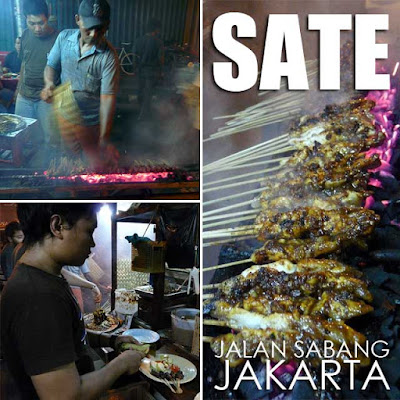
In a previous trip to Jakarta, I had a hawker food overload in Kelapa Gading. There was a lot of stuff I really enjoyed. So during this trip, after dinner with SSEAYP friends, I made sure to drop by again.
Unfortunately, on the way there, it started to rain really hard. So by the time we arrived in Wisma Gading, the warung were closing shop much earlier than schedule (it was a Friday night even) since the rains had prevented people from trooping over for yummy servings of warung food.

Good thing there was one warung open which served dessert roti. The warung kopi served roti panggang or grilled bread. Yes, you heard me right, grilled! It's the basic loaf bread sandwich with fillings that include chocolate, pineapple or strawberry jam, peanut butter, egg, corn or cheese or a combination of these. Then the sandwich is grilled to a toast over hot charcoal.
We chose the Roti Serikaya which is grilled coconut custard sandwich, and Roti Tape Pisang Spesial. Tape is fermented cassava while pisang is banana. They grill the tape and bananas first before placing them between the bread together with butter, cheese and chocolate sprinkles called meises (influence from the Dutch chocolade hagelslag). Then they grill the sandwich and slice it into bite-sized pieces.
It's damn good! And you could really taste the fermented tape. Eating tape is actually an acquired taste. So if you're not an adventurous eater, you're better off with the safer choices.

Anyway, since I was frustrated that we didn't get to binge on more warung food, we tried to look for hawker stall or food outlet that was still open. And we saw two across the street. One was a Chinese restaurant which served food very common in Medan. Contrary to popular belief, they do serve pork in Jakarta, particularly in areas where there is a high concentration of Chinese.

The restaurant is called Kaca Mata. We had a sampler plate which included Bebek Panggang Peking (grilled Peking duck), Siobak or Babi Panggang (roasted pork belly which tastes more like lechon kawali) and Chasio Garing Madu (honeyed barbecued pork which tastes like tocino) and Chasio Biasa. Cha sio or char siu is barbecued pork which is very popular in Medan.
Thanks to Ron Rada for this food adventure in Kelapa Gading and the previous one in 2007! For an even more comprehensive feature of food in Kelapa Gading, check out Indonesian food trip.





























